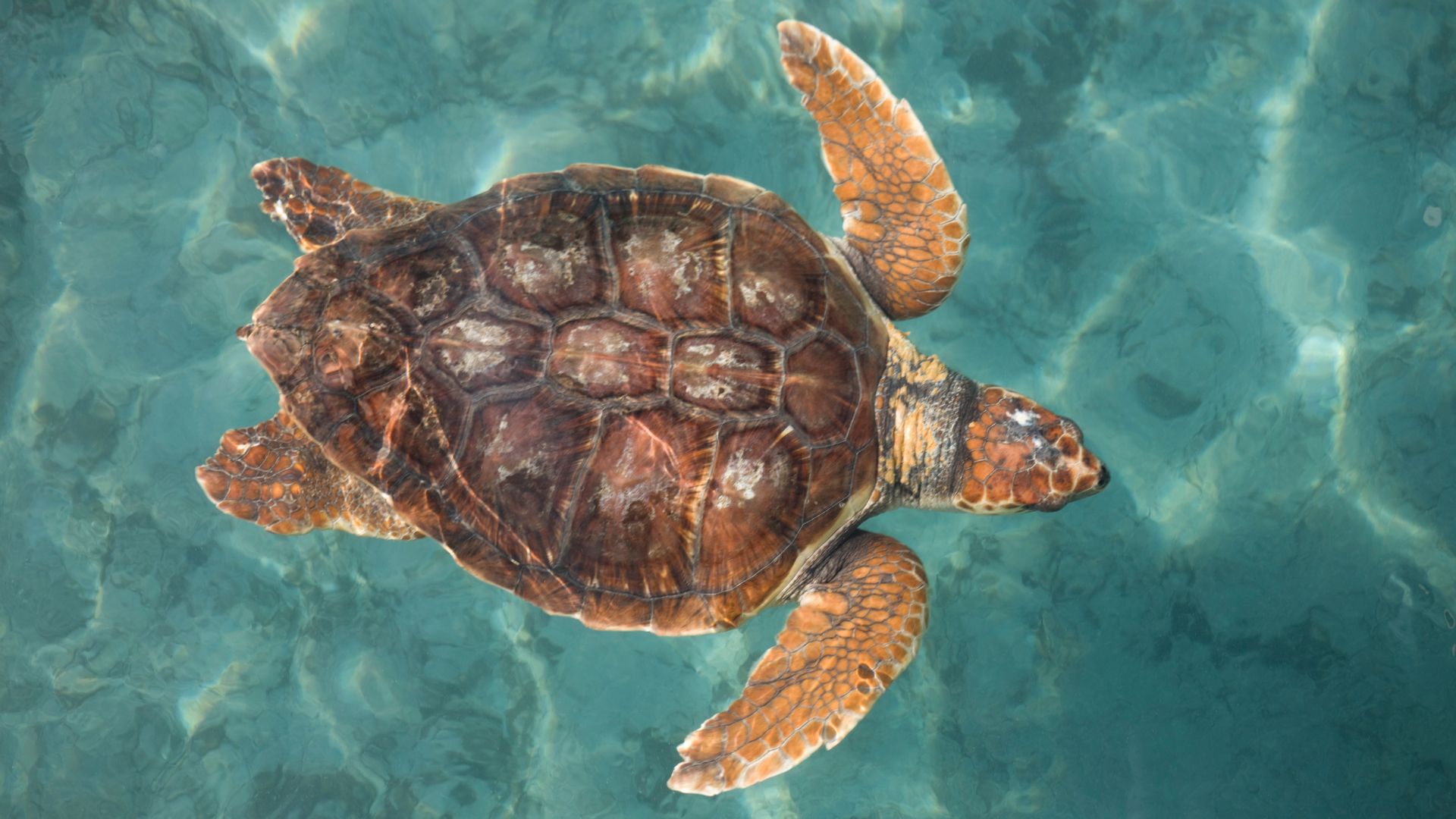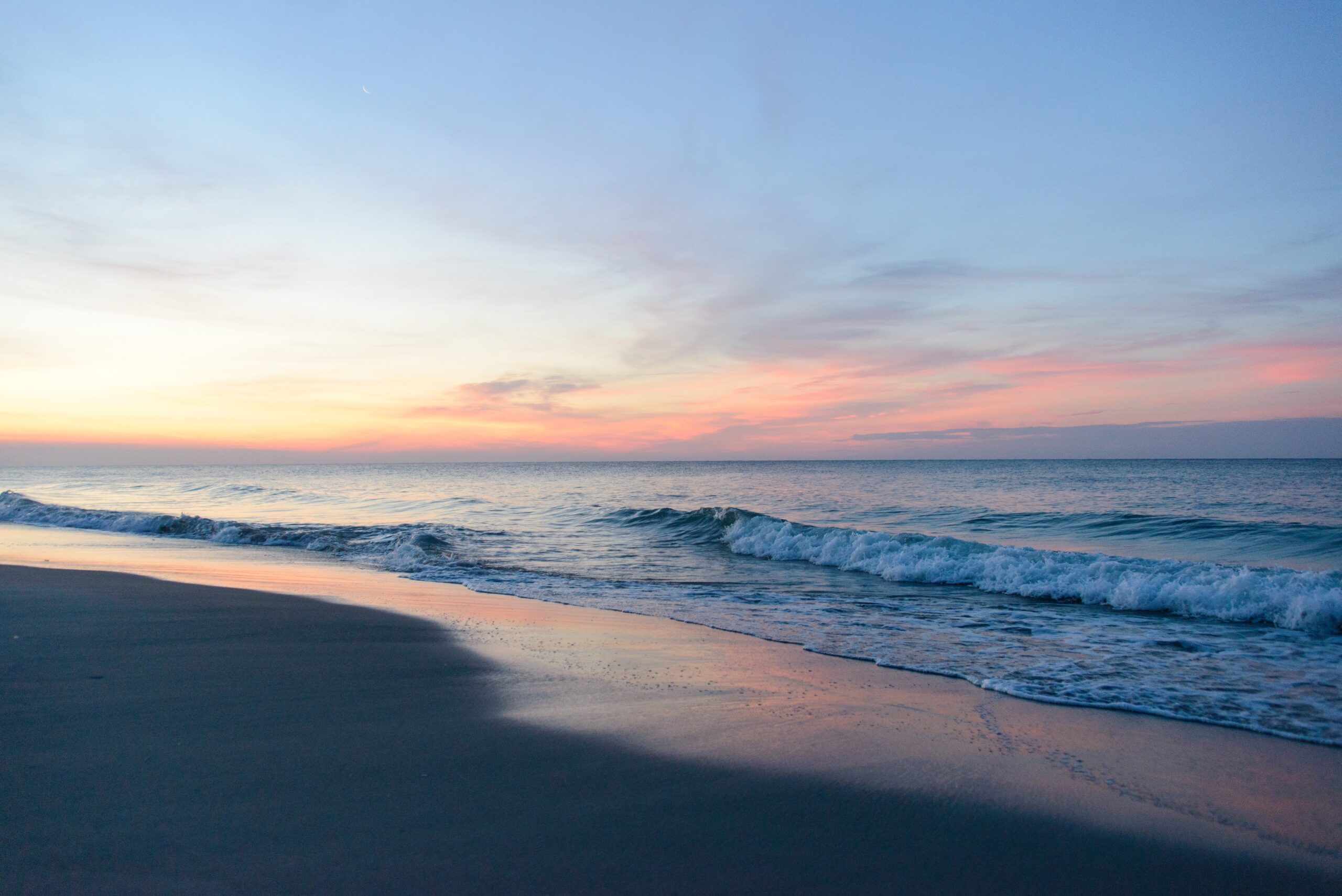You’re never alone on Myrtle Beach. There might be times during the off-season when the beach looks deserted, but looks can be deceiving. The sand beneath your feet is every bit as full of life as the boardwalk attractions, and running the whole show is the ever-changing moon, whether you can see it during daylight hours or not. Like a symphony conductor the moon cues the tides, calms the waves, stirs up the waves, and ushers in the next generation of aquatic plants and animals – invisibly, mysteriously, like some cosmic clockwork.
The wildlife you’ll find on the seashore is dependent on the tides, the sand, the sun and the storms, and while you might not always notice the shells and beach critters around you, they’ve been calling the sandy beaches of Myrtle Beach home for thousands of years.
What You’ll Find
The five-pointed star
Welcome to a secret society formed around the meaning and the symbolism of the number five – the sign of the echinoderms.
One member is the sand dollar, also known as the keyhole urchin, thin as a wafer so that it may slide obliquely into the sand, passing effortlessly from sunlight into a dark underground bunker. At the center of its flat disk is a five-petal flower, blooming within a surface covered with spines, soft to the touch and shimmering in the sunlight.
Other echinoderms share its underground lairs, such as starfish and a closely related cousin, the heart urchin, a lump of a creature with the sign of the five-pointed star carved into its upper crust. The heart urchin is never seen above ground, at least not while it’s alive. A thin shell bearing the secret sign might be blown about by the wind and left in the pile of litter at the high-tide line.
A star-like pattern sometimes marks the entrance to the underground hideout and when that image is disturbed, it trembles and fades, leaving one to wonder whether they’d seen it or not. Meanwhile, the starfish silently glides away, paddling through the sand on flattened tube feet. It will not long abandon its family compound, an underground city of chimneys, stacks, ventilating pipes, passages, and runways.
The wonderful world of worms
Members of the beach-dwelling worm clan include sand filtration engineers, suit makers, architects, builders and exterior decorators.
Let’s start with the ecologist, the lugworm that passes massive quantities of sand and soil through its body. At the end of the day, it has leavened and renewed the beach and brought about a proper balance of decaying organic matter. Where you see round black domes that look like small volcanoes, the lugworm itself is nearby. The domes are neat, coiled castings that represent the work output while the lugworm lies U-shaped in the sand and mud. It takes in sand and water at one end of the “U” and pumps it out the other. Its egg sacks bob around in the water like small flotation devices, pink and translucent, containing as many as 300,000 eggs.
Another relative is the trumpet worm, who suits up in a cone-shaped tube made out of finely worked mosaics of sand grains cemented together by a secretion from the worm. It painstakingly creates this suit to protect its soft body while it tunnels, and it is the masterpiece of a lifetime never surrendered until that lifetime has expired. Discarded tubes are among the tidal debris at the high tide line.
The parchment worm creates an underground compound beneath two small twin chimneys that, again, are connected by a subterranean U-shaped tube. It fans the water through the dark tunnel to bring in food, carry off waste and sow the seeds for the next generation. After a larval stage spent on the high seas, it settles on the beach to make short, mucus-coated tunnels, each one progressively larger to accommodate the worm’s growth. It doesn’t make plans for the growth of unwelcome lodgers, however, and young crabs that sneak into the tube can grow too large to get out. Luckily for the worm, there’s another exit.
The plumed worm is known as the decorator worm due to its flair with shell and seaweed. It also is known as Diopatra and it builds only one little protruding chimney which it festoons with bits of shell and seaweed, presumably for camouflage rather than for aesthetics. This little guy risks life and limb to get his display just right, exposing its defenseless body to predators during the search for suitable decorative materials which it glues to its chimney.
Marine versus land animal
The sand hopper, also known as the beach flea, is probably the most conflicted creature on the planet as to whether it belongs in the category of marine life or whether it should be reclassified as one of the terrestrials.
The sand hopper has made the long trek to the upper beach in its quest for dry land but it is tragically bound to the sea, which both nourishes and threatens the little anthropod. It is a poor swimmer and never enters the water voluntarily, and so it roams the intertidal zone at low tide, preferably at night, gnawing at bits of sea lettuce, eelgrass or kelp and finding morsels of fish or crab shells, phosphates, nitrates and other mineral substances. Eventually, it must find refuge from daylight or high tide or both.
Every day is a new excavation job, a new burrow to dig, a task so repetitive that the sand hopper has it done in about ten minutes. It crawls inside as the tide rises overhead, and feels the vibrations of breaking waves and incoming tides. Somehow it senses the tide going out and the sun going down, and then it pops out and resumes the hunt in the retreating line of white froth that stretches across a darkened beach.
Myrtle Beach Ecosystem: Where You’ll Find Them
From the moon’s point of view
The Atlantic coast curves inward in the long stretch between Cape Canaveral, Florida and Cape Fear, NC. The concave configuration of the coasts of Georgia and South Carolina mostly shields those beaches from major storms and also somehow creates a texture in their sands that is a mixture of mud and clay. It is a firm texture that allows nature’s small diggers to create permanent holes and burrows and also facilitates the fine art of sculpture. The surf zone retains ripple marks long after the tide has gone out that look like miniature models of the waves themselves.
The beach has such a gentle slope that the lowest ebb of the tide reveals as much as a quarter mile of sand that was beneath the waves during high tide. The ripples retain food articles dropped by the receding waves and little pools and creeks spread across this terrain, teeming with small creatures that caught the last wave in and must wait for hours before catching the first wave out.
Those temporary offshore creeks may contain sea pansies, pink and lavender flower-like faces that are not plants but animals. They surface only on overcast days and belong to a family that includes jellyfish, sea anemones and corals. After dark they are luminescent in the shallow water, glowing softly with hundreds of little lights in a serpentine line.
Tiny creatures living in the surf zone have adapted to its changing moods. Air breathers burrow into the sand on a rising tide and thrust upward their long breathing tubes or siphons. Sand dwellers burrow into the deep wet layers when the water ebbs away. Worms build calcareous tubes, seal the opening with a gill filament that works like a cork in a bottle, and release their larvae into neap tides, giving their young a chance to learn to swim before the water gets rough again.
Barnacles and snails open their shells to an incoming tide and close up tight to hold in the moisture. Scuds and beach fleas hide under rocks and weeds to wait for the next incoming tide. Brown seaweed indigenous to the Carolina coast releases its reproductive cells only on the full moon, an apparent response to polarized light on protoplasm.
Some of the surf zone dwellers live on higher ground where the spring tide visits only twice a month. During the long dry times, they very nearly hibernate, having stored nutrition and captured sufficient moisture to hold them over until the next spring tide.
No doubt this is where that old expression “tide you over” originated.
Homeless, tempest-tossed
The Gulf Stream follows the outer edge of the continental shelf from Florida to Cape Hatteras, moving northward, bringing up temperatures and carrying migratory sea life looking for temporary or permanent relocation. Some immigrants negotiated a transatlantic passage between Africa and Europe to America and the Caribbean, and in some mystical way we also sometimes see species from the Pacific and Indian oceans.
Their trade routes are not well understood. They move through northern waters where there are shallows, ridges, and islands that serve as way stations, but in lower latitudes, no such rest stops exist. The immigrants may arrive on floating timber or drifting seaweed, and once they make it to the Caribbean they can hitch a ride on the Gulf Stream to Myrtle Beach. Starfish, shrimp, crayfish and mollusks are examples of West Indian species closely related to African species that are now residing along the Carolina coast.
You never know what might turn up on these shores. Over the centuries so-called “red tides” have discolored the sea with an extraordinary multiplication of some minute form, probably a dinoflagellate, that has killed massive numbers of fish and invertebrates.
The cast of characters changes again out on the shifting shoals and along the coast of sea islands. Fiddler crabs skitter across mud flats, making little chit-chit sounds while lady crabs bury themselves up to their eyeballs in the sandy bottoms of shallow water. Snails with neat black spirals trace clear tracks across the sand and toadfish huddle in clumps of eelgrass. Contact us today!



